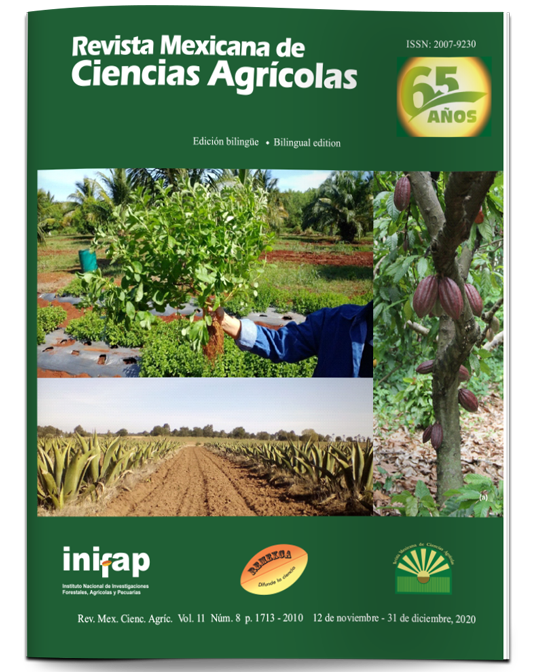Proximal analysis of chihua pumpkins accessions in the Yucatán Peninsula
DOI:
https://doi.org/10.29312/remexca.v11i8.1931Keywords:
Cucurbita argyrosperma Huber, biodiversity, native pumpkinAbstract
The objective of the work was to determine the content of protein and dry matter in the seed (%PROTSEMC, %MATSSEMC), shell (%PROTCASC, %MATSCASC) and pulp (%PROTPULC, %MATSPULC), and percentage of carbohydrates (%CARBCA), fat (%GRASCRU) and ash (%CENCA) in the seed of six accessions of chihua pumpkins (Cucurbita argyrosperma Huber), native to the Yucatán Península. The accessions evaluated were: Becal, Edzna, Pixoyal, Chihua local, CACAO and CECHET. The sowing was carried out in June 2017 in Pocyaxum, Municipality of San Francisco de Campeche, Mexico, in a randomized block design with three repetitions, analysis of variance and mean comparisons were performed with the Tukey test (p≤ 0.05). The experimental unit consisted of three rows of 6 m in length, separated at 2.40 m and 1.25 m between plants. For the determination of proteins, the Kjeldahl method was used, and following the process described in AOAC (2000). The CECHET accession showed higher (p≤ 0.05) %PROTESEMC, %PROTCASC, %MATSSEMC and %MATSPULC with 33.6, 14.4, 64.9 and 4.29%, respectively. Edzna, Becal, Local Yucatan presented 3.8% PROTPULC less (p≤ 0.05) compared to the CECHET, CACAO and Pixoyal accessions. Edzná presented higher (p≤ 0.05) % GRASCRU with 45.3%. Becal, presented the highest (p≤ 0.05) %CARBCA with 34.7%. The % MATSCASC of the CACAO accession (12.5% MATSCASC) exceeds (p≤ 0.05) those obtained in the rest of the accessions. There were no differences (p≤ 0.05) for the %CENCA. The accession that stood out was CECHET, with the highest percentage of protein in seed, peel, pulp and dry matter in seed and pulp. Accessions with nutritional intake for consumption were identified that can be an alternative for preparing different foods.
Downloads
Published
How to Cite
Issue
Section
License
Copyright (c) 2020 Revista Mexicana de Ciencias Agrícolas

This work is licensed under a Creative Commons Attribution-NonCommercial 4.0 International License.
The authors who publish in Revista Mexicana de Ciencias Agrícolas accept the following conditions:
In accordance with copyright laws, Revista Mexicana de Ciencias Agrícolas recognizes and respects the authors’ moral right and ownership of property rights which will be transferred to the journal for dissemination in open access. Invariably, all the authors have to sign a letter of transfer of property rights and of originality of the article to Instituto Nacional de Investigaciones Forestales, Agrícolas y Pecuarias (INIFAP) [National Institute of Forestry, Agricultural and Livestock Research]. The author(s) must pay a fee for the reception of articles before proceeding to editorial review.
All the texts published by Revista Mexicana de Ciencias Agrícolas —with no exception— are distributed under a Creative Commons License Attribution-NonCommercial 4.0 International (CC BY-NC 4.0), which allows third parties to use the publication as long as the work’s authorship and its first publication in this journal are mentioned.
The author(s) can enter into independent and additional contractual agreements for the nonexclusive distribution of the version of the article published in Revista Mexicana de Ciencias Agrícolas (for example include it into an institutional repository or publish it in a book) as long as it is clearly and explicitly indicated that the work was published for the first time in Revista Mexicana de Ciencias Agrícolas.
For all the above, the authors shall send the Letter-transfer of Property Rights for the first publication duly filled in and signed by the author(s). This form must be sent as a PDF file to: revista_atm@yahoo.com.mx; cienciasagricola@inifap.gob.mx; remexca2017@gmail.
This work is licensed under a Creative Commons Attribution-Noncommercial 4.0 International license.



